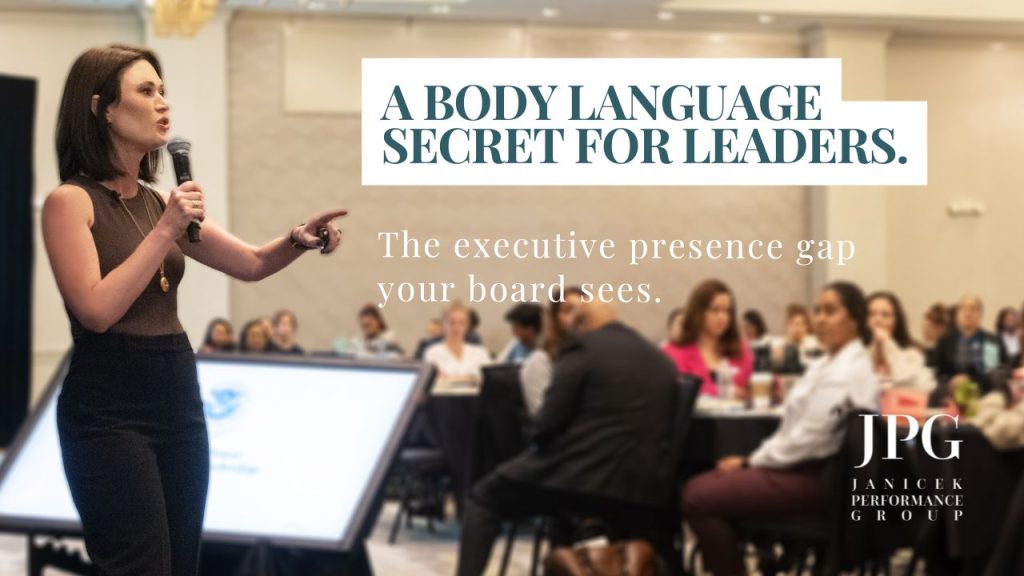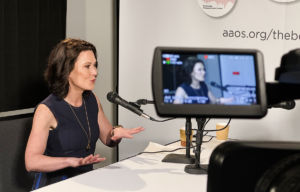Executive Presence Starts with Awareness, Not Perfection
Before you say a single word, your audience is already forming an opinion.
It starts with your body.
And most often, it starts with your hands.
I’ve coached thousands of executives, emerging leaders, and high-stakes speakers. And there’s one pattern I see over and over, especially in moments that matter most:
We bring our hands up.
Right in front of our chest. Guarding our core. Clutching a pointer. Fidgeting with a ring. Folding them tightly in front of us like armor.
Why does this happen?
Public speaking, even in a boardroom, not a ballroom, triggers a primal instinct to protect ourselves.
You’re exposed. You’re hoping to be liked. You’re working hard to sound smart, credible, in control.
You want to be seen, but you’re also subconsciously protecting yourself from being judged.
That protective posture makes perfect sense. But here’s the thing:
The message your body sends might be undermining the message you’re trying to deliver.
When your hands are clutched close to your chest, your audience sees hesitation.
When your gestures are tight or overly rehearsed, they see nervousness.
When your body looks guarded, they feel your insecurity even if your words say otherwise.
And when you’re leading the room, that’s not the impression you want to leave behind.
Want to Lead with More Confidence? Start with Your Body.
This isn’t about perfection. It’s about intentionality.
You’ve already done the hard work. Developing the strategy, refining the data, preparing the message.
Now let your presence support the power of your words.
Here are five simple ways to align your body language with your message:
1. Lower Your Hands
Let your arms rest naturally at your sides or loosely in front of you. This signals confidence, calm, and openness.
When in doubt, start with hands at your side and use purposeful, intentional gestures to reinforce your words. Avoid the “T-Rex” position (hands clutched just below your neck) or the “fig leaf” (hands locked low in front of your body). Both restrict your energy and your message.
2. Ground Yourself
Before you speak, take a beat.
Feel your feet planted.
Breathe.
A grounded posture, shoulders back, spine tall, projects stability and authority. It also calms your nervous system and centers your attention.
3. Use Open Gestures
When you gesture, open your palms. Let your movements be natural, not scripted.
This creates connection. It communicates transparency and authenticity. Two of the most important traits in any leader.
4. Practice With Intention
Record yourself. Watch with the sound off.
Where are your hands? What is your body language saying without your voice?
Self-awareness is the first step toward transformation.
5. Remember This: You Are Enough
You don’t need to overcompensate with grand gestures or constant movement.
Your message is strong. Your presence matters. And you don’t need to earn the right to be in the room. You already belong there.
Let your body reflect the confidence you’ve already earned.
Confidence is Contagious. So is Nervous Energy.
If your body language is broadcasting self-doubt, the room will feel it.
But when you ground yourself, when you own your presence, people don’t just hear you.
They trust you. They believe you. They follow you.
This is the power of executive presence.
And it starts long before you ever open your mouth.
At Janicek Performance Group, we specialize in training leaders to accelerate growth, command attention, and drive innovation through impactful communication. If you’re ready to refine your presence, project confidence, and take control of your message, reach out today to learn how we can help.





